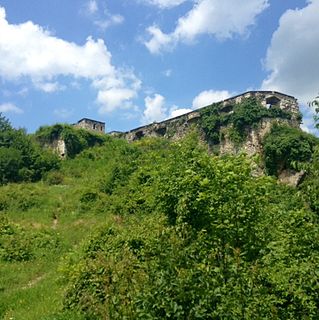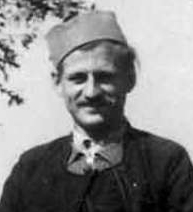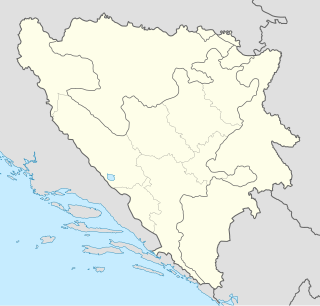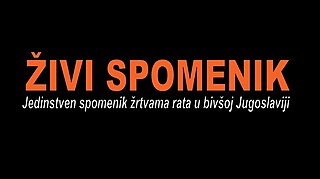
Doboj is a city located in Republika Srpska, an entity of Bosnia and Herzegovina. It is situated on the banks of Bosna river, in the northern region of the Republika Srpska. As of 2013, it has a population of 71,441 inhabitants.

Zvornik is a city in Bosnia and Herzegovina. It is located in entity of Republika Srpska, on the left bank of the Drina river. As of 2013, it has a population of 58,856 inhabitants.

The Republika Srpska was a self-proclaimed proto-state in Southeastern Europe under the control of the Army of Republika Srpska during the Bosnian War. It claimed to be a sovereign state, though this claim was not recognized by the Bosnian government, the United Nations, or any other recognized state. For the first few months of its existence, it was known as the Serbian Republic of Bosnia and Herzegovina.

The Trnopolje camp was an internment camp established by Bosnian Serb military and police authorities in the village of Trnopolje near Prijedor in northern Bosnia and Herzegovina, during the first months of the Bosnian War. Also variously termed a concentration camp, detainment camp, detention camp, prison, and ghetto, Trnopolje held between 4,000 and 7,000 Bosniak and Bosnian Croat inmates at any one time and served as a staging area for mass deportations, mainly of women, children, and elderly men. Between May and November 1992, an estimated 30,000 inmates passed through. Mistreatment was widespread and there were numerous instances of torture, rape, and killing; ninety inmates died.
Dragan Obrenović is a former Bosnian Serb senior officer and commander in the Yugoslav People's Army (JNA) and the Bosnian Serb Army (VRS).
The Yellow Wasps were a Serbian paramilitary group which was active in the Bosnian War. It was headed by Vojin Vučković and Dušan Repić. The group was active in the Zvornik region. Vojin and his brother Duško were convicted in 1996 for killing of 17 civilians in Čelopek, a suburb of the town of Zvornik, during the ethnic cleansing of the Bosniak population of the Drina valley in 1992. Four other members of the group have also been charged with war crimes.

The Čemerno massacre refers to the massacre of ethnic Serbs of the village of Čemerno, Ilijaš, in the Ilijaš Municipality, near Sarajevo, on 10 June 1992, during the Bosnian War.

The Zvornik massacre refers to acts of mass murder and violence committed against Bosniaks and other non-Serb civilians in Zvornik by Serb paramilitary groups at the beginning of the Bosnian War in 1992. It was part of a wider campaign of ethnic cleansing in the Bosnian War: by one estimate, 40,000 Bosniaks were expelled from the Zvornik district.

Zvornik Castle, also known as the Old Town of Zvornik and Kula Grad, is a medieval castle located in Zvornik, Bosnia and Herzegovina, on the mountain Mlađevac overlooking Drina Valley. Zvornik fortress is 147 metres (482 ft) above sea level.

Filip "Fića" Kljajić was a Yugoslav Partisan fighter during World War II and political commissar of the 1st Proletarian Brigade. Kljajić was killed during the Battle of Zvornik and posthumously awarded the Order of the People's Hero on 25 September 1944.
Liplje is a mountain village located in the municipality of Zvornik, Bosnia and Herzegovina, neighboring Snagovo. Within Liplje there are 14 settlements: Bajrići, Bećirovići, Čamlija, Hadžići, Husići, Jašići, Jošanica, Kadrići, Korin Brijeg, Liplje, Salihovići, Samari, Sultanovići and Velja Glava.

The Batković camp was a prison camp operated between 1992 and 1996 by Bosnian Serb authorities in Batković, a village in the municipality of Bijeljina, Bosnia and Herzegovina during the Bosnian War. It is believed to have been the first concentration camp of the Bosnian war, set up for Bosniak (Muslim) and Croat men, women and children, in an effort to ethnically cleanse the areas under Bosnian Serb control. Detainees were held in two large barns and tortured, deprived of food and water, forced to dig trenches, carry ammunition to the front lines, work in fields and factories and bury the dead. Prisoners were subject to daily beatings, sexual assault and forced to beat one another.

The Snagovo massacre refers to the mass killing of 36 Bosnian Muslim civilians by Serbs on 29 April 1992 in the village Snagovo, located in the municipality of Zvornik, Bosnia and Herzegovina. The massacre occurred at the start of the Bosnian War.

On 27 April 2015, a local gunman attacked a police station in Zvornik in the Republika Srpska entity of Bosnia and Herzegovina. He killed one police officer and wounded two others before he was shot dead by other police officers. This was the first attack of its kind in Republika Srpska; attacks have occurred in the other entity, the Federation of Bosnia and Herzegovina, including the 1997 Mostar car bombing.

The Bijeli Potok massacre refers to the mass killing of 684 Bosniak civilians by Serbs on 1 June 1992 in the settlement Bijeli Potok within the village Đulići, located in the municipality of Zvornik, Bosnia and Herzegovina. About 684 Bosniak men and boys, from the multiple villages around Zvornik, were separated from their families by Serb forces, and slaughtered within a week at Bijeli Potok and their bodies hidden in mass graves throughout the Drina Valley.
The Battle of Zvornik was the 1943 capture by the 1st Proletarian Brigade of the occupied Bosnian town Zvornik from the Wehrmacht and the Ustasha troops of the occupying Independent State of Croatia.

Living monument are the commemorations to the victims of past war in the former Yugoslavia organized by the UDIK.

The Gospić concentration camp was one of 26 concentration camps in the Independent State of Croatia during World War II, established in Gospić.
Radio Glas Drine or RGD is a Bosnian group of commercial radio stations, broadcasting from Sapna, Bosnia and Herzegovina. It broadcasts a variety of programs such as news, music, morning and talk shows. A network of Radio Glas Drine radio stations is available in the Bosansko Podrinje and Bosnian-Podrinje Canton area, Semberija, Bosanska Posavina and Tuzla Canton area.














